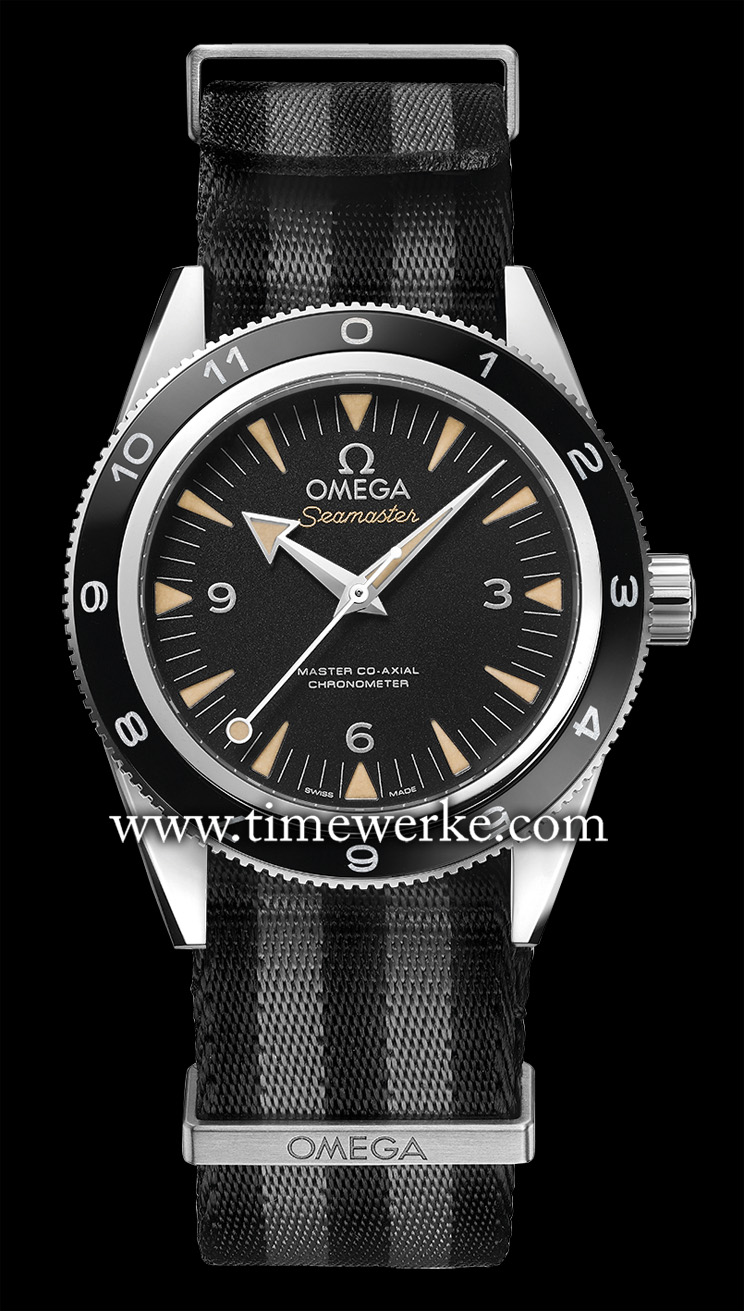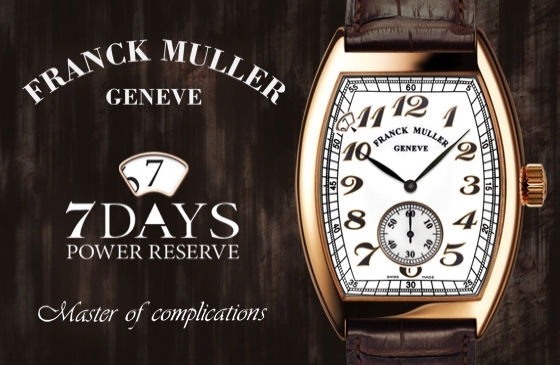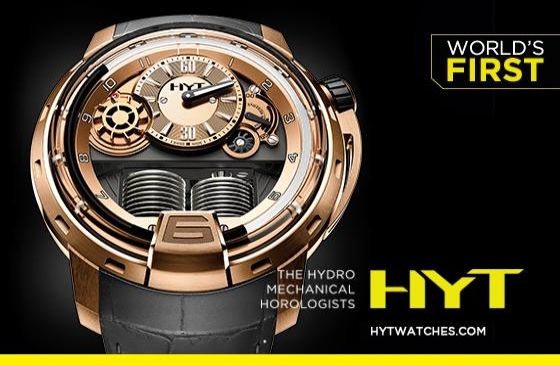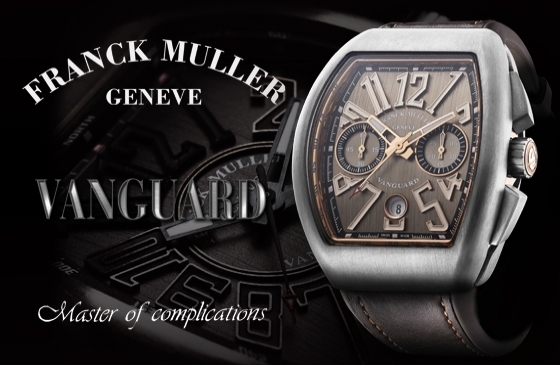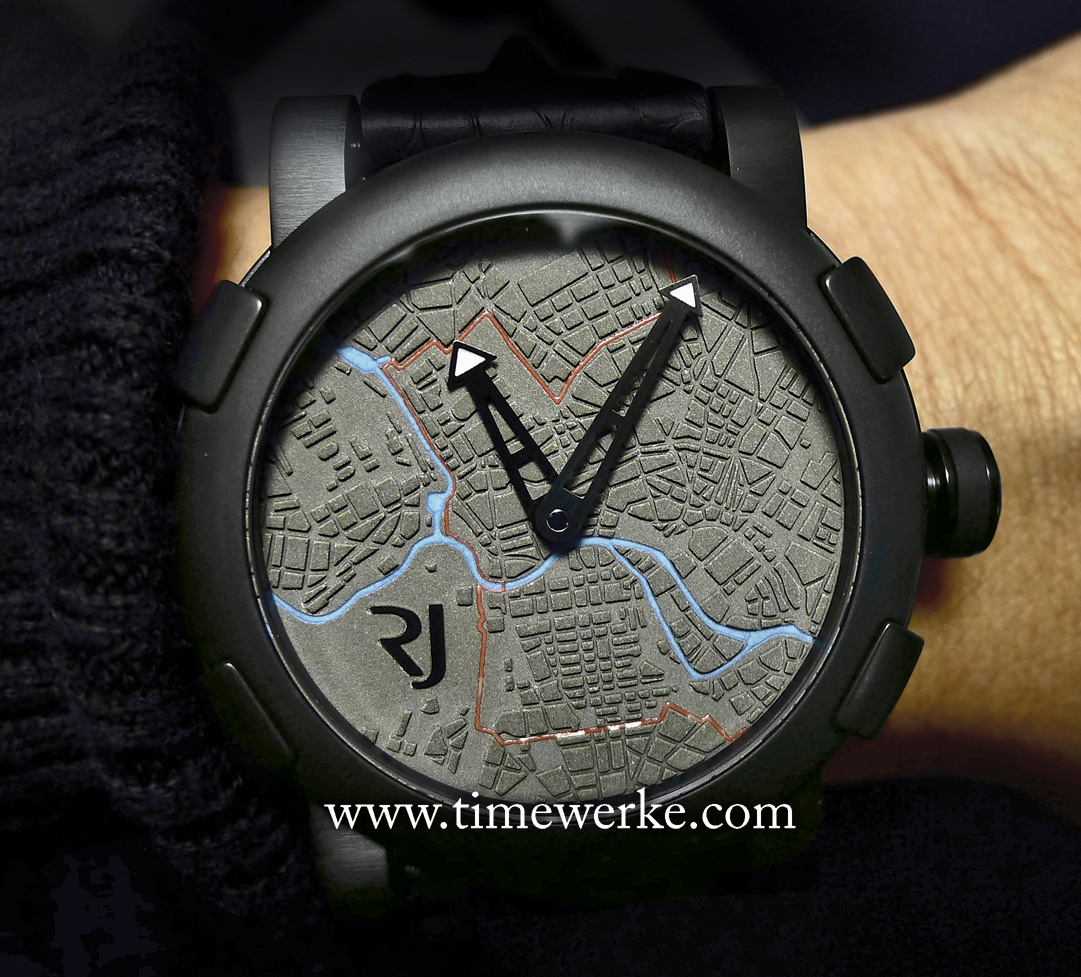
RJ-Romain Jerome Berlin-DNA in a 46mm diameter case in black PVD-coated steel and matt black ceramic bezel. The dial features part of the map of Berlin. The lines in red indicate where the Berlin Wall once stood while the blue lines represent the Spree River. Priced at CHF12,950. Photo: © TANG Portfolio. Elfa / Timmy. 2015.
After the Second World War, Germany and its territories were divided into four allied occupational zones with the Soviets taking the eastern half and the Allies (the United States, Great Britain and France) having the western side.
It was a similar split for the German city of Berlin and the four-way occupation began in June 1945. Similarly, the Soviets occupied the east and the Allies the west.
On 13 August 1961, the German Democratic Party (GDR or East Germany) began erecting a barrier using barbed wire fencing and building a concrete wall that separated East and West Berlin. It became known as the Berlin Wall.
After the Berlin Wall was built, travelling officially from East to West was only possible through three checkpoints: “Checkpoint Alpha” at Helmstedt, “Checkpoint Bravo” at Dreilinden and “Checkpoint Charlie” at Friedrichstrasse. There were eventually 12 checkpoints along the wall built by the GDR.
The Berlin Wall was known as the Antifaschistischer Schutzwall (the “Anti-Fascist Protective Wall) and was officially meant to keep out Western fascists from entering East Germany and undermining the Socialist state. The Berlin Wall’s other “unofficial” purpose was to prevent mass defections from East to West.
The “unofficial” opening of the Berlin Wall and its borders came a day earlier, on 9 November 1989. Günter Schabowski (1929 to 2015) was the East German official who gained worldwide fame for his blunder that caused the Berlin Wall to open earlier than expected.
During a news conference on 9 November 2015, Schabowski had announced that East Germany was lifting travel restrictions across its border with West Germany. Schabowski was then a member of the Soviet bloc’s ruling Politburo and spokesman.
Asked when the travel regulation would take effect, Schwabowski slipped up after looking at his notes and stammered, “As far as I know, this enters into force… this is immediately, without delay.”
Schwabowski also added that every citizen of the German Democratic Republic could leave East Germany through the border crossings.
In actual fact, the announcement was only supposed to have been released at 4am on 10 November 1989.
The Western media promptly picked up news of the lifting of travel restrictions and it spread like wildfire. It was reported that more than two million people from East Berlin crossed into West Berlin over that weekend, to escape and to celebrate.
The East German border guards were overwhelmed by the civilian crowds. It was reported that they eventually relented and opened the gates without much checks on those who passed through.
“At the time, East German leaders saw the opening of the Berlin Wall as a relief valve amid huge pro-democracy protests and a flight of citizens to the West via other countries. The wall’s opening set in motion a series of events that led to German reunification on 3 October 1990,” reports the Washington Post.
Schabowski eventually turned his back publicly against communism in 2001. The 86-year old Schabowski recently passed away on 1 November 2015 in a nursing home in Berlin.
Actual demolition of the Berlin Wall only began in summer of 1990 and it was completed in 1992.
It was after German reunification in 1990 that the East Side Gallery gathered 118 artists from around the world to paint a 1.3km stretch of the Berlin Wall along the east side. The East Side Gallery is the longest open-air gallery in the world with 106 large paintings.
It is known as an international memorial for freedom attracting more than 1.3 million visitors each year.
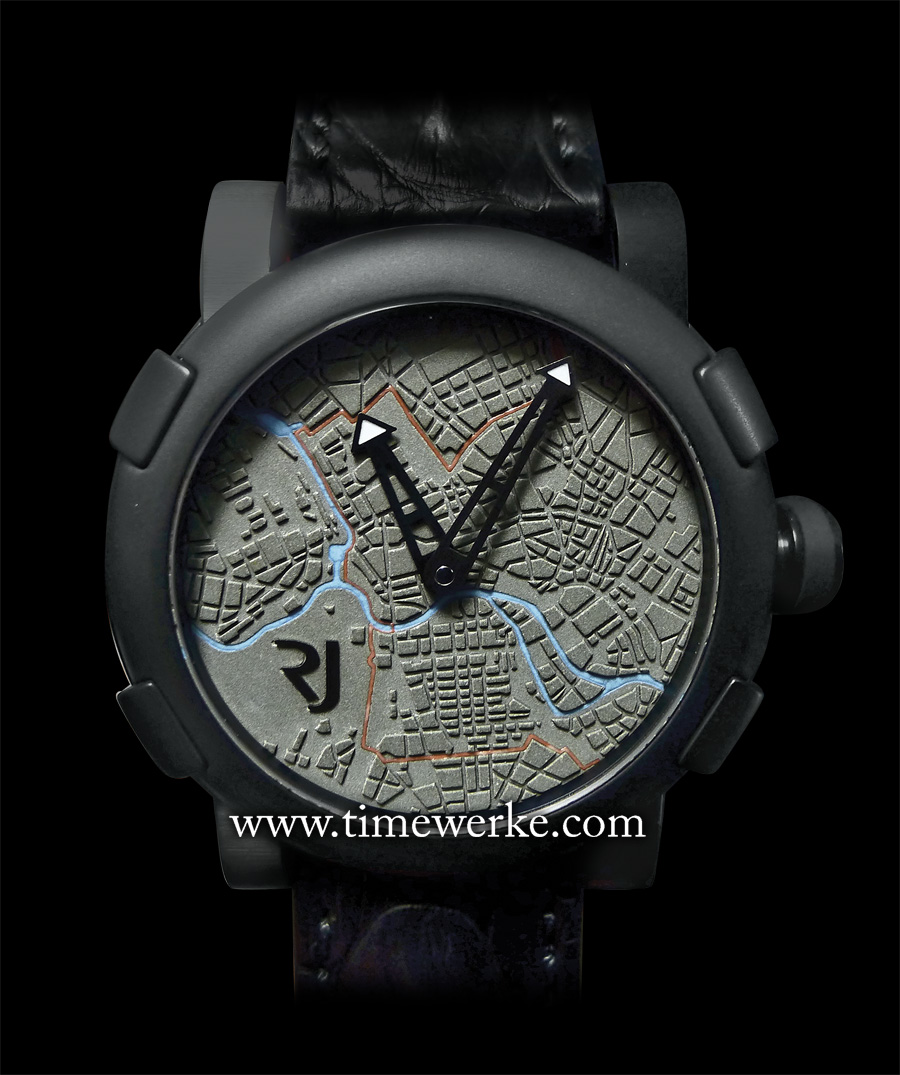
Cement fragments from the Berlin Wall were collected and these have been integrated into the dial. In addition to the attraction on the dial, there is more to view on the case back of this RJ-Romain Jerome Berlin-DNA watch. Photo: © TANG Portfolio. Elfa / Timmy. 2015.
In collaboration with the East Side Gallery, RJ-Romain Jerome, inspired by the fall of the Berlin Wall, launched a limited edition watch known as the Berlin-DNA. Proceeds from the sale of the Berlin-DNA watch will also go to the East Side Gallery where the artwork on the walls face threats such as pollution, destruction and vandalism.
What is so intriguing and special about the watch is more than just the cement from the Berlin Wall (fragments were collected) that has been integrated into the dial; it is the design of the dial itself where a section of Berlin with outlines of three-dimensional streets and buildings are shown.
On the dial, the route of the Berlin Wall is in red (and coated with green SuperLuminova) while a blue line (coated with blue SuperLuminova) represents the Spree River. The entire dial is in SuperLuminova to allow the streets and open spaces to light up in darkness.
“The East Side Gallery embodies both a piece of art and a piece of history… The [Berlin] Wall is a constant reminder of the passion and commitment behind the quest for people’s freedom, and translates the euphoria felt in the wake of reunification!” says RJ-Romain Jerome CEO Manuel Emch.
What is on the back of the RJ-Romain Jerome is even more startling – it has one of the most famous paintings on the Berlin Wall of the East Side Gallery – “The Brother Kiss” painted by Russian Dmitri Vrubel.
“With this partnership [between RJ-Romain Jerome and the East Side Gallery], we want to set an example by preserving art and historical vestige,” says Emch.
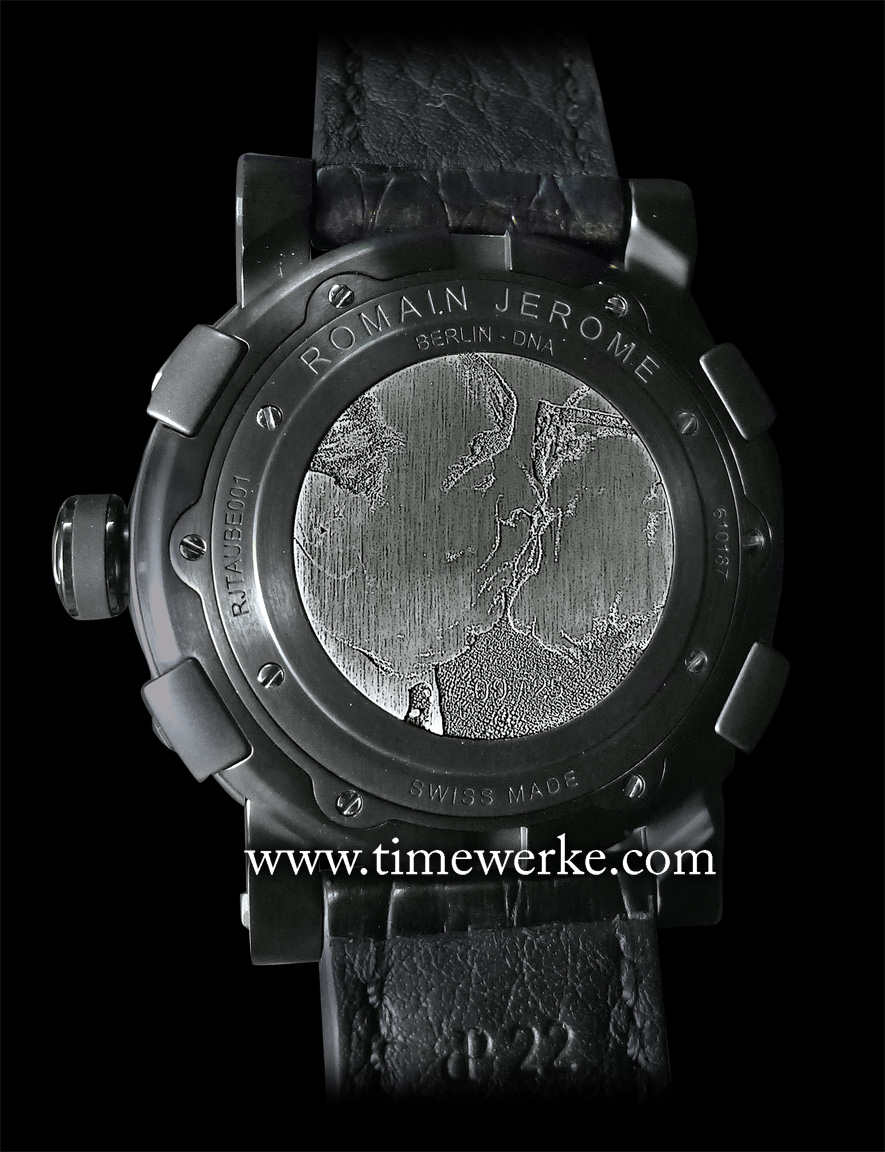
The engraving of the Socialist fraternal kiss between Leonid Brezhnev and Erich Honecker. Soviet leader Leonid Brezhnev (1906 to 1982) ruled the Soviet Union from 1964 till his death in 1982. Erich Honecker (1912 to 1994) led the German Democratic Party from 1971 till its downfall in 1989. Photo: © TANG Portfolio. Elfa / Timmy. 2015.
We actually like how the two major artistic elements associated with the Berlin Wall are separated – one on each side of the Berlin-DNA watch such that focus on either one is kept in place.
For us, the RJ-Romain Berlin-DNA is a door to a not-so-distant past where freedom was craved. It is a reminder to appreciate what we have and the bonus is the creative artistry on this watch.
Inspired by an actual photo taken in 1979, Vrubel painted this kiss between Soviet leader Leonid Brezhnev (who ruled from 1964 till his death in 1982) and Erich Honecker (1912 to 1994) who led the German Democratic Party from 1971 till its downfall in 1989.
It was a Socialist fraternal kiss between the two leaders. Such a practice typically involves an embrace and a mutual kiss on the cheeks. What is somewhat surprising is that both gentlemen engaged in a lip-locking kiss, which is generally rare.
The Socialist fraternal kiss took place in 1979 during celebrations of the 30th anniversary of the German Democratic Republic of East Germany, after Brezhnev made his speech. The actual photo of the kissing event was captured by Regis Bossu.
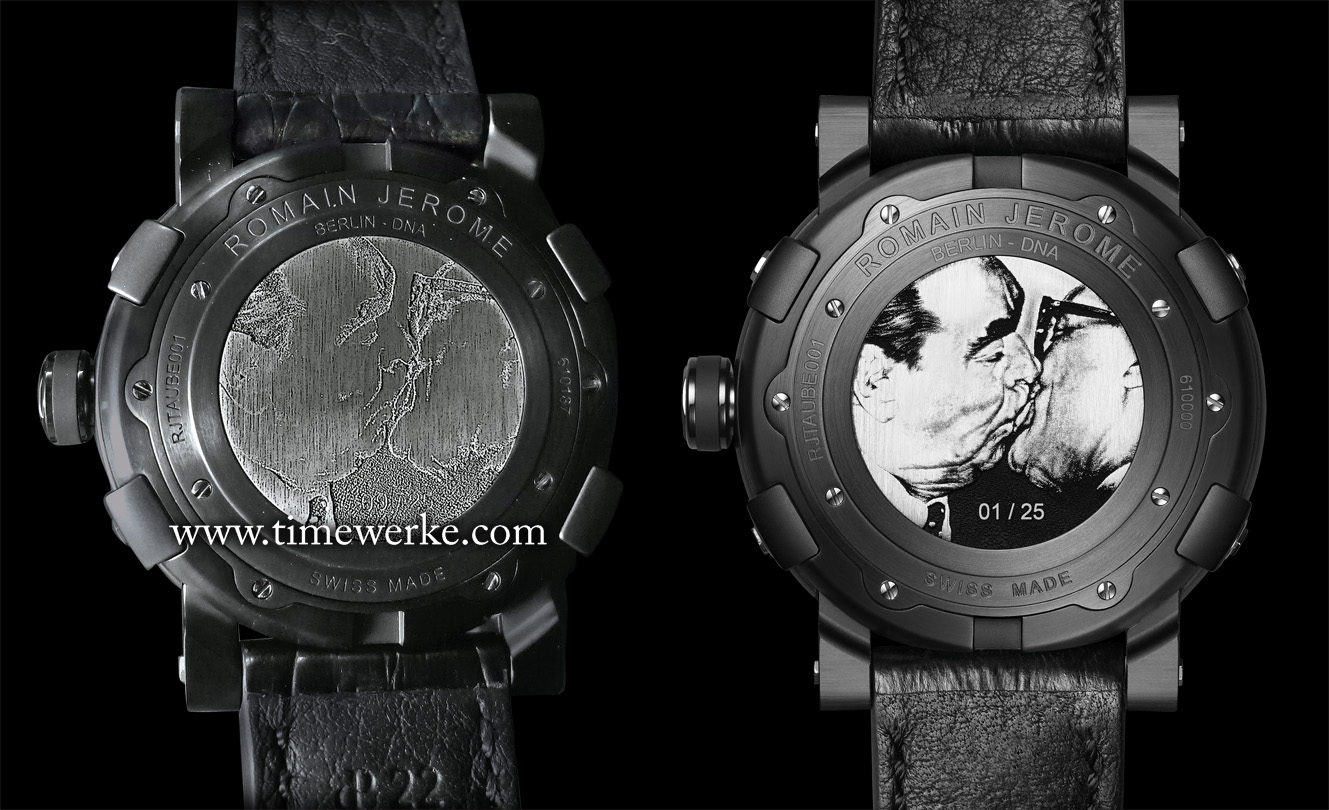
Compare the engraving of the Socialist fraternal kiss (left) with that of the print (right). Photo of the case back engraving: © TANG Portfolio. Elfa / Timmy. 2015. Photo of the case back with print: © RJ-Romain Jerome
According to rarehistoricalphotos.com, “… the kiss wasn’t exactly shocking – except for the enthusiasm both men showed for the lip lock”.
Their politically correct description did not dampen our surprise for the kiss and neither does it change our enthusiasm and positive views on the creative artistry behind this RJ-Romain Jerome Berlin-DNA watch.
We would personally advise reserving such “enthusiasm” and action exclusively for your better half.
